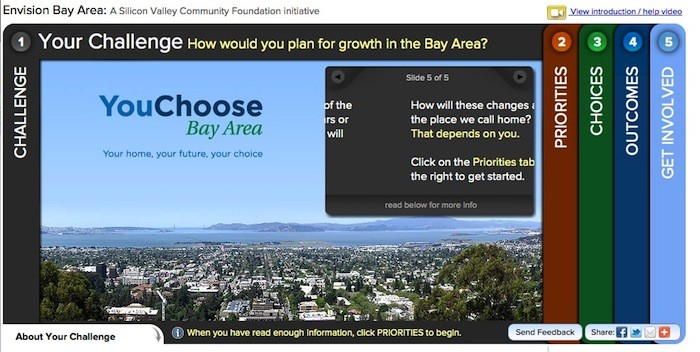
YouChoose Bay Area project brings Silicon Valley planning to life
The recent earthquake and tsunami in Japan has only emphasized the intense need for strong public policy planning for our most populated regions of the US. Back in 2009, The Silicon Valley Community Foundation applied to The Knight Community Information Challenge for support to help answer the questions of what the San Francisco Bay area should and could look like by 2035, when there could be 1.2 million new jobs and 900,000 new households.
The question the SVFoundation team wanted to answer was would it be possible to build an online planning tool that could be a focal point to help both regional planned and the informed public explore and answer regional planning and land use questions such as:
- Where will all of these people live?
- Where will the new housing be built? How will people get around?
- Will the air we breathe and the water we drink be clean?
- Will we still be able to enjoy extensive and accessible open spaces?
With the support of a $302,000 grant from Knight, the SV Foundation, in partnership with Greenbelt Alliance, TransFormCA and others, created a new tool–YouChoose Bay Area–that takes the questions of the Envision Bay Area project and turns them into an interactive online visualization tools. Working within a clear and easy to use interface, the website allows users to make choices that show them the impact of different policy choose and how they dictate future growth in the region. Participants get an understanding of fiscal impact, public health, GHG emissions, travel behavior, building energy and water consumption as they use the tool, and can see how policy choices might turn into new realities.
Built by Calthorpe Associates, a Berkeley-Ca based firm that also works on the Vision California project, YouChoose Bay Area is also the centerpiece for 5 county-wide forums that the Silicon Valley Foundation and its partners will hold to train people in using the tool and to discuss regional planning issues.
As SVCF were developing their online tool, they shared compelling data forecasting greenhouse gas emissions with their regional planning commission. As Margot Rawlins, Initiative Officer, describes, “Using the EBA data, we showed that a reduction (in greenhouse gases) of 15% would have a much more positive impact on the region … That led to the board overruling the initial 10% reduction target with the higher reduction target of 15%. This was a substantial win in influencing government bodies and setting more aggressive environmental targets, and it happened before our initiative was even public.”
Recent Content
-
Community Impactarticle ·
-
Community Impactarticle ·
-
Community Impactarticle ·


